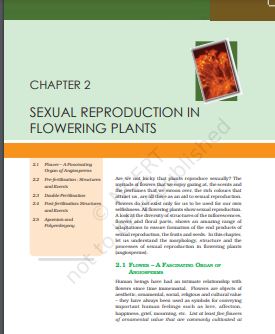
Chapter 2: Sexual Reproduction in Flowering Plants
Are we not lucky that plants reproduce sexually? The myriads of flowers that we enjoy gazing at, the scents and the perfumes that we swoon over, and the rich colors that attract us, are all there as an aid to sexual reproduction.
Flowers do not exist only for us to be used for our own selfishness. All flowering plants show sexual reproduction.
A look at the diversity of structures of the inflorescences, flowers, and floral parts, shows an amazing range of adaptations to ensure the formation of the end products of sexual reproduction, the fruits, and seeds.
In this chapter, let us understand the morphology, structure, and processes of sexual reproduction in flowering plants (angiosperms).
2.1 FLOWER – A FASCINATING ORGAN OF ANGIOSPERMS
Human beings have had an intimate relationship with flowers since time immemorial.
Flowers are objects of aesthetic, ornamental, social, religious, and cultural value – they have always been used as symbols for conveying important human feelings such as love, affection, happiness, grief, mourning, etc.
List at least five flowers of ornamental value that are commonly cultivated in homes and in gardens.
Find out the names of five more flowers that are used in social and cultural celebrations in your family. Have you heard of floriculture – what does it refer to?
To a biologist, flowers are morphological and embryological marvels and the sites of sexual reproduction. In class XI, you have read the various parts of a flower.
Figure 2.1 will help you recall the parts of a typical flower. Can you name the two parts in a flower in which the two most important units of sexual reproduction develop?
2.2 PRE-FERTILISATION: STRUCTURES AND EVENTS
Much before the actual flower is seen on a plant, the decision that the plant is going to flower has taken place.
Several hormonal and structural changes are initiated which lead to the differentiation and further development of the floral primordium.
Inflorescences have formed that bear the floral buds and then the flowers. In the flower, the male and female reproductive structures, the androecium and the gynoecium differentiate and develop.
You would recollect that the androecium consists of a whorl of stamens representing the male reproductive organ and the gynoecium representing the female reproductive organ.
As each cell of the sporogenous tissue is capable of giving rise to a microspore tetrad. Each one is potential pollen or microspore mother cell.
The process of formation of microspores from a pollen mother cell (PMC) through meiosis is called microsporogenesis.
The microspores, as they are formed, are arranged in a cluster of four cells–the microspore tetrad (Figure 2.3 a).
As the anthers mature and dehydrate, the microspores dissociate from each other and develop into pollen grains (Figure 2.3 b). Inside each microsporangium, several thousands of microspores or pollen grains are formed that are released with the dehiscence of the anther (Figure 2.3 c).
Pollen grain: The pollen grains represent the male gametophytes. If you touch the opened anthers of Hibiscus or any other flower you would find deposition of yellowish powdery pollen grains on your fingers. Sprinkle these grains on a drop of water taken on a glass slide and observe under.
| Author | – |
| Language | English |
| No. of Pages | 23 |
| PDF Size | 34.2 MB |
| Category | Biology |
| Source/Credits | – |
Related PDFs
Sexual Reproduction in Flowering Plants PDF Free Download
